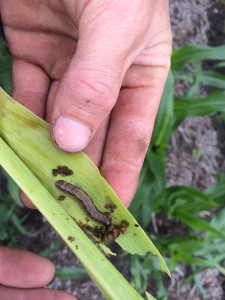Resistant Fall Armyworm Has Shown Up Early
go.ncsu.edu/readext?301101
en Español / em Português
El inglés es el idioma de control de esta página. En la medida en que haya algún conflicto entre la traducción al inglés y la traducción, el inglés prevalece.
Al hacer clic en el enlace de traducción se activa un servicio de traducción gratuito para convertir la página al español. Al igual que con cualquier traducción por Internet, la conversión no es sensible al contexto y puede que no traduzca el texto en su significado original. NC State Extension no garantiza la exactitud del texto traducido. Por favor, tenga en cuenta que algunas aplicaciones y/o servicios pueden no funcionar como se espera cuando se traducen.
Português
Inglês é o idioma de controle desta página. Na medida que haja algum conflito entre o texto original em Inglês e a tradução, o Inglês prevalece.
Ao clicar no link de tradução, um serviço gratuito de tradução será ativado para converter a página para o Português. Como em qualquer tradução pela internet, a conversão não é sensivel ao contexto e pode não ocorrer a tradução para o significado orginal. O serviço de Extensão da Carolina do Norte (NC State Extension) não garante a exatidão do texto traduzido. Por favor, observe que algumas funções ou serviços podem não funcionar como esperado após a tradução.
English
English is the controlling language of this page. To the extent there is any conflict between the English text and the translation, English controls.
Clicking on the translation link activates a free translation service to convert the page to Spanish. As with any Internet translation, the conversion is not context-sensitive and may not translate the text to its original meaning. NC State Extension does not guarantee the accuracy of the translated text. Please note that some applications and/or services may not function as expected when translated.
Collapse ▲ Last year I reported that Cry1F resistant fall armyworm was present in North Carolina. These insects can easily survive on corn with the Herculex, and Optimum Intrasect traits, as well as WideStrike cotton (all contain Cry1F, highly toxic to fall armyworm- unless they are resistant). It is thought that fall armyworm is a migratory pest in North Carolina and that they cannot overwinter in the state- and we have had a hard winter! However, I recovered large fall armyworm larvae from Herculex-traited corn whorls in Hyde County on May 29 this year. I was speaking at a cotton production meeting this February with snow falling on the ground a few miles from the site where I collected these larvae; to me, it seems unlikely that they survived the winter here. Generally we do not experience fall armyworm pressure until late-August unless a tropical storm blows the moths up earlier. Since we have not had this weather yet this year, I’ll be honest that I am puzzled how they got here. Fall armyworm experts that I contacted are puzzled as well.
Last year I reported that Cry1F resistant fall armyworm was present in North Carolina. These insects can easily survive on corn with the Herculex, and Optimum Intrasect traits, as well as WideStrike cotton (all contain Cry1F, highly toxic to fall armyworm- unless they are resistant). It is thought that fall armyworm is a migratory pest in North Carolina and that they cannot overwinter in the state- and we have had a hard winter! However, I recovered large fall armyworm larvae from Herculex-traited corn whorls in Hyde County on May 29 this year. I was speaking at a cotton production meeting this February with snow falling on the ground a few miles from the site where I collected these larvae; to me, it seems unlikely that they survived the winter here. Generally we do not experience fall armyworm pressure until late-August unless a tropical storm blows the moths up earlier. Since we have not had this weather yet this year, I’ll be honest that I am puzzled how they got here. Fall armyworm experts that I contacted are puzzled as well.
What does this mean for us going forward? To my knowledge, this resistance and early pressure is a new phenomenon. I am worried that 2014 may be a heavy worm year. I would like to urge county agents, consultants and growers to be vigilant in corn and cotton containing Cry1F. These early populations will reproduce and re-infest in our state. The densities that I recovered this May were very low. However, these populations will cycle through multiple generations and could blow up on us this summer. I will be closely monitoring the situation. Please report any suspicious fall amryworm activity to me.


